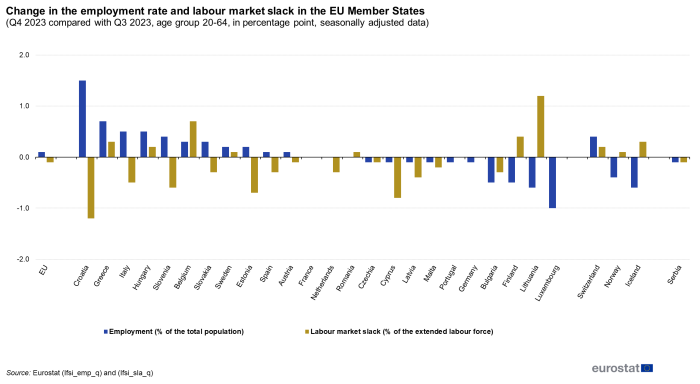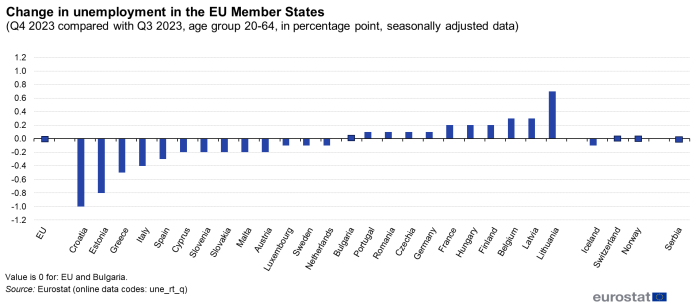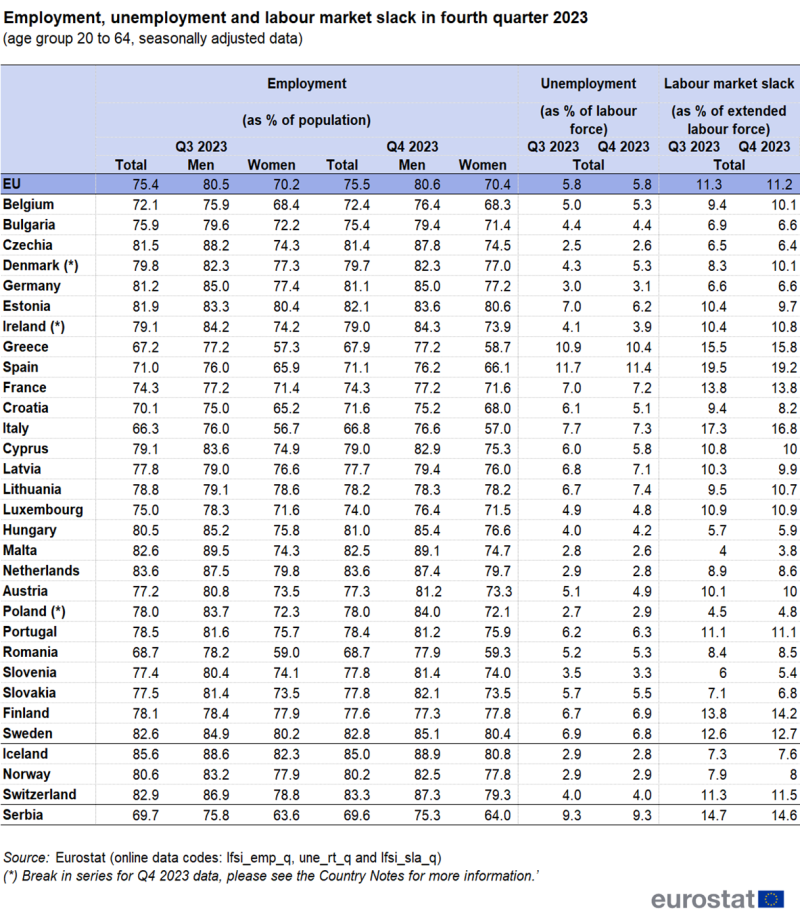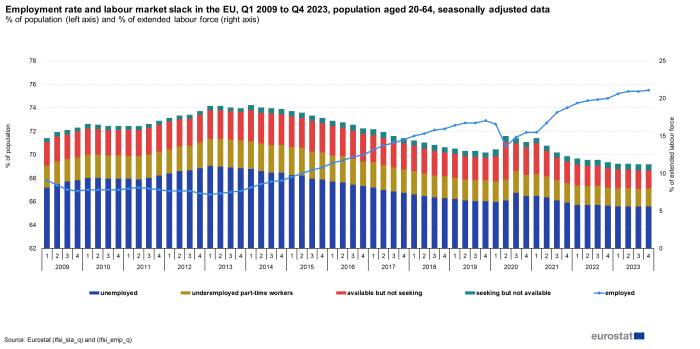Employment rate up and Labour Market Slack down in the EU
In the fourth quarter of 2023, 196.0 million persons in the EU were employed. The EU seasonally adjusted employment rate for people aged 20-64 years stood at 75.5 %, up from 75.4 % in the third quarter of 2023, as shown in Figure 1.
For the same period, the seasonally adjusted total labour market slack in the EU, which is the unmet need for work, amounted to 24.0 million persons, which represented 11.2 % of the extended labour force in the fourth quarter of 2023 , down from 11.3 % in the third quarter of 2023. Regarding its main component, unemployment, 12.1 million persons were unemployed in the fourth quarter of 2023 and the EU seasonally adjusted unemployment rate was 5.8 % stable compared with the third quarter of 2023. Underemployed part-time workers accounted for 2.4 % of the extended labour force (+0.1 percentage points (pp) compared with the third quarter of 2023), those available for work but not seeking work accounted for 2.4 % (-0.1pp compared with third quarter of 2023) and those actively seeking work but not available to take up work accounted for 0.8 % (stable compared with third quarter of 2023).
(%)
Source: Eurostat (lfsi_sla_q) and (lfsi_emp_q)
Lithuania, Belgium and Finland see the greatest increase in labour market slack
Compared with the third quarter of 2023, for countries where comparable data are available, labour market slack decreased in 13 Member States in the fourth quarter of 2023. It remained stable in Germany, France, Luxembourg and Portugal and increased in 7 countries. The largest increases were reported in Lithuania (+1.2 pp), Belgium (+0.7 pp) as well as in Finland (+0.4 pp).
The employment rate changed between the third quarter of 2023 and the fourth quarter of 2023 across the EU Member States, except in France, the Netherlands and Romania where it remained stable. The largest decreases were recorded in Luxembourg (-1.0 pp), Lithuania (-0.6 pp), Bulgaria and Finland (both -0.5 pp). By contrast, the highest increases in employment were recorded in Croatia (+1.5 pp), Greece (+0.7 pp) as well as in Italy and Hungary (both +0.5 pp), as displayed in Figure 2.

(percentage points)
Source: Eurostat (lfsi_emp_q) and (lfsi_sla_q)
Focus on the gender gap in employment development
When looking at the development of the employment rate, the gender employment gap in the EU decreased by 0.1 pp between the third quarter of 2023 and the fourth quarter of 2023. While the employment rate of women increased by +0.2 pp, the employment rate of men increased by +0.1 pp. The largest changes in gender gaps among EU Member States were found in Croatia
(-2.6 pp due to an increase of +2.8 pp for women and an increase of 0.2 pp for men), Luxembourg
(-1.8 pp due to an decrease of -0.1 pp for women and a decrease of -1.9 pp for men), Greece (-1.4 pp due to an increase of +1.4 pp for women and remained stable for men), Cyprus (-1.1 pp due to an increase of +0.4 pp for women and a decrease of -0.7 pp for men), Slovenia (+1.1 pp due to a decrease of -0.1 pp for women and an increase of +1.0 pp for men), Finland (-1.0 pp due to a decrease of -0.1 pp for women and a decrease of -1.1 pp for men)
and Latvia (+1.0 pp due to a decrease of -0.6 pp for women and an increase of +0.4 pp for men) as shown in Figure 3.

(percentage points)
Source: Eurostat (lfsi_emp_q)
Unemployment in the EU Member States
Comparing the third quarter of 2023 with the fourth quarter of 2023, the unemployment rate at EU level (the aggregate of all 27 Member States) remained stable at 5.8 % of the labour force.
The highest decreases were registered in Croatia (from 6.1 % to 5.1 %), Estonia (from 7.0 % to 6.2 %), Greece (from 10.9 % to 10.4 %) and Italy (from 7.7 % to 7.3 %). The unemployment rate remained unchanged in Bulgaria while it increased in 10 other countries. The highest increases were observed in Lithuania (from 6.7 % to 7.4 %), Latvia (from 6.8 % to 8.1 %) and Belgium (from 5.0 % to 5.3 % ) as shown in Figure 4.

(percentage points)
Source: Eurostat (une_rt_q)
Main indicators

Source: Eurostat (une_rt_q), (lfsi_sla_q) and (lfsi_emp_q)
Source data for tables and graphs
Data sources
All figures in this article are based on seasonally adjusted quarterly results from the European Union Labour Force Survey (EU-LFS).
The European Union labour force survey (EU-LFS) is the largest European household sample survey providing quarterly and annual results on labour participation of people aged 15 years and over as well as on persons outside the labour force. It covers residents in private households. Conscripts in military or community service are not included in the results. The EU-LFS is based on the same target populations and uses the same definitions in all countries, which means that the results are comparable between countries.
The labour market indicators published from the first quarter of 2021 are based on the EU Labour Force Survey (EU-LFS) under the Regulation (EU) No 1700/2019 on European statistics relating to persons and households, based on data at individual level collected from samples. Quarterly series for main indicators before 2021 are back-calculated in line with the new methodology up to the first quarter of 2009, see here.
Main methodological information
Country notes:
- The Netherlands collect quarterly LFS data using a rolling reference week instead of a fixed reference week, i.e. interviewed persons are asked about the situation of the week before the interview rather than a pre-selected week.
- Denmark, Ireland and Poland: Break in series for the fourth quarter of 2023 due to changes applied on the raw data.
- Bosnia: Not adjusted data available for the first time for the period 2021Q1-2023Q3, downloadable in Eurobase. Adjusted data will become available for Bosnia after the delivery of Q4 2023 LFS data.
Methods and definitions:
Eurostat produces harmonised labour market data for individual EU Member States, the euro area and the EU. The concepts and definitions used in the Labour Force Survey follow the guidelines of the International Labour Organisation.
Employed persons are all persons who worked at least one hour for pay or profit during the reference week or unpaid for a business owned by a member of the family, or were temporarily absent from such work. The employment rate is the percentage of employed persons in relation to the total population.
The Gender Employment Gap is the difference between the employment rates of men and women aged 20-64 years.
Unemployed persons are all persons who:
- are without work;
- are available to start work within two weeks;
- and have actively sought employment at some time during the previous four weeks.
The labour market slack is the sum of unemployed persons, underemployed part-time workers, persons seeking work but not immediately available and persons available to work but not seeking, expressed as percentage of the extended labour force.
Underemployed part-time workers are persons working part-time who wish to work additional hours and are available to do so. Part-time work is recorded as self-reported by individuals.
Persons seeking work but not immediately available are the sum of persons neither employed nor unemployed who: (a) are actively seeking work during the last four weeks but not available for work in the next two weeks; or (b) found a job to start within a period of at most three months and are not available for work in the next two weeks; or (c) found a job to start in more than three months but are not available for work in the next two weeks.
Persons available to work but not seeking are the sum of persons neither employed nor unemployed who want to work and (a) are available for work in the next two weeks but are not seeking work, or (b) were passively seeking work during the last four weeks and are available for work in the next two weeks or (c) found a job to start in more than three months and are available to work in the next two weeks.
The extended labour force is the total number of people employed plus unemployed, plus those seeking work but not immediately available plus those available to work but not seeking. In this article, data cover persons aged 20 to 64 years.

